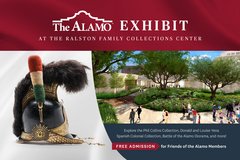Work on the sloping of the curbs in front of the Church were completed the week before Thanksgiving. In addition, the handrails located at the ends of each slope were also able to be installed prior to the Holiday week. Once the sloped area was completed, the crews moved on to the perimeter of the Plaza to prepare for safety bollard installation. During the week of November 22, the H-E-B Christmas Tree was installed in the Plaza.
Archaeology Update — Exploratory Excavations in the Temporary Sacristy Room
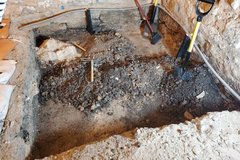
Excavations associated with the Church focused on two sets of units. Units 3 and 4 are being excavated to expose the foundation of a portion of the south wall of the Church. Units 5 and 6 are focused on revealing the foundation of a current interior wall, located on the north side of the nave.
On the south side of the Church, under the weatherproofing tarp, excavations continued, revealing mixed soils. Portions of the unit exhibited dark, almost black clay, whereas other areas had a light brown soils with lots of pea-sized gravels. Artifacts encountered included construction materials (concrete, brick, tile, limestone), glass, and metal fragments.
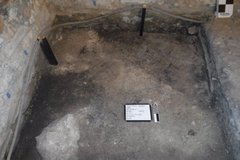
During the week, additional utilities (one metal irrigation pipe and two PVC electrical conduits) were uncovered and removed within the unit. Soils showed signs of heavy disturbance with mottled colors and pockets of construction sand throughout. Prior to stopping for the Thanksgiving break, the unit exhibited a trench outline running diagonal. The trench outline likely indicates the presence of another buried utility.
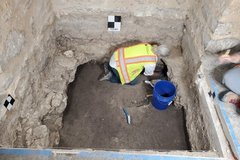
Exploratory excavations for inside the south side of the Church continued during the week of November 16 with the completion of Level 2 (11–15 inches below datum) and the beginning of Level 3 (15–19 inches below datum). Evidence of a kick out in the wall was noted on the south side of the unit. The kick out begins at 17 inches below datum, measures 6.2 inches wide on average, and spans the 6.5 foot length of the unit, including along the base of the pilaster.
Evidence of a compacted caliche floor was also observed during Level 3 excavations at 18.8 inches below datum. The fragmented caliche surface appears is only present near the southern boundary of the unit, adjacent to the kick out, indicating that some disturbance had impacted the majority of the surface.
Artifacts noted during excavations of this unit included unidentifiable metal fragments, clear flat glass fragments, one olive container glass fragment, red brick fragments, charcoal fragments, and copper wire fragments.
Exploratory excavations for the unit located in the room just north of the Church nave continued with the completion of Level 5 (27.5–31.4 inches below datum), Level 6 (31.4–35.4 inches below datum), and the beginning of Level 7 (35.4–39.3 inches below datum).
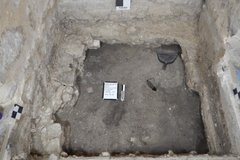
The room is referred to as the Temporary Sacristy. The room was actually an exterior patio, accessible from the Convento Courtyard, during the Mission Period.
Excavations removed a majority of the compacted caliche surface identified the previous week that spanned the majority of the unit at 24 inches below datum. The caliche surface averaged approximately 7.8 inches thick throughout. Continued excavations further defined a limestone kick out that follows most of the east, south, and west Church walls that boarder the unit, including the pilaster along the southwestern corner of the unit.
A dark brown silty clay soil was encountered beneath the compacted caliche surface. The darker soil contained mostly ceramics, charcoal flecks, red brick fragments, slag, chipped stone flakes, and snail shell.
Excavations are set to resume after the Thanksgiving break. There are still two more pairs of units to open in and around the Church (four units total) as well as one more in the Convento Courtyard.

